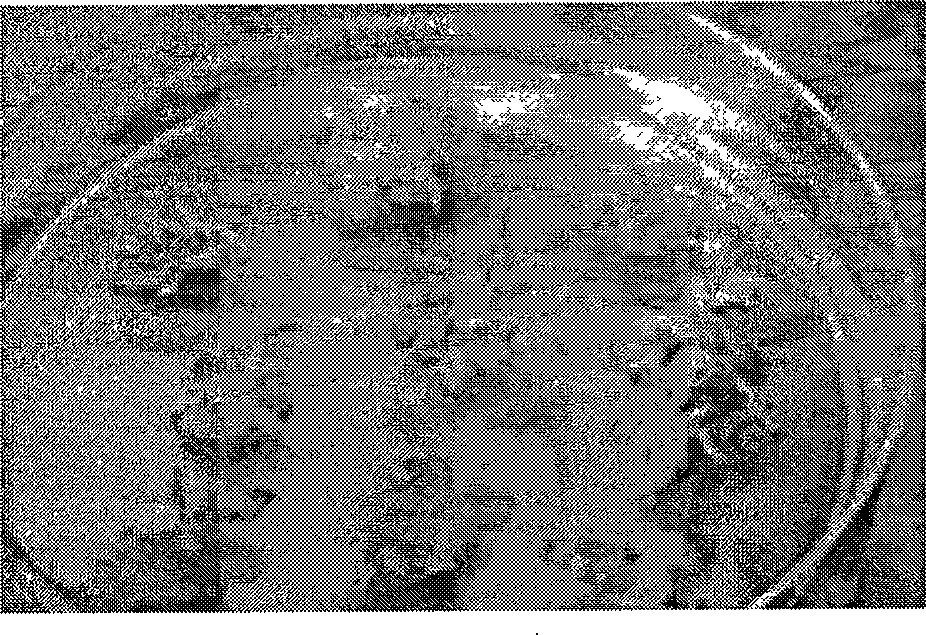Method for enhancing conversion efficiency of garlic by agrobacterium tumefaciens and the garlic prepared thereby
A transformation efficiency, Agrobacterium technology, applied in biochemical equipment and methods, horticultural methods, botanical equipment and methods, etc., can solve the problem of low transformation efficiency and achieve the effect of improving transformation efficiency
- Summary
- Abstract
- Description
- Claims
- Application Information
AI Technical Summary
Problems solved by technology
Method used
Image
Examples
Embodiment 1
[0032] Embodiment 1, inducing callus from the root tissue of the cultivated plant and redifferentiating the plant
[0033] When inducing callus from the root tissue of cultured garlic plants, adding 2,4-D and IAA to MS medium was more effective than adding 2,4-D and 2ip (isopentenyl adenosine) to induce callus. 83% higher induction rate. The optimum concentrations of added 2,4-D and IAA were 1 mg / L and 0.2 mg / L, respectively (Table 1). If the concentration of 2,4-D and IAA is too high, it will affect the redifferentiation of plants. When plants were redifferentiated in the medium supplemented with 5 mg / L kinetin and 1 mg / L NAA, the redifferentiation rate reached 51%, but the plants could not be redifferentiated when only kinetin was added (Table 3).
Embodiment 2
[0034] Embodiment 2, conversion and screening
[0035] Studies have shown that: in the garlic gene transformation, the GFP expression of the callus is more when the Agrobacterium and the callus are co-cultured for 6 days; , or in 1 / 2 N6 medium supplemented with 1mM MES, 200mg / L cysteine and 100mg / L DTT for about 6 days, the conversion efficiency can be improved; among them, the best The combination is to add 1 mM of MES and 200 mg / L of cysteine in 1 / 2N6 medium (Table 2). Under this condition, the transformation efficiency is improved more effectively than other methods. The selection of the transformant was carried out by inoculating the cell body on the MS medium supplemented with 25mg / L of hygromycin; after culturing for 12 weeks, the tissue identified as expressing GFP under the microscope was subcultured ( figure 2 and image 3 ). In the past, gusA was used as the marker gene, and the observed tissue could not be reused after observing the tissue; however, the met...
Embodiment 3
[0036] Embodiment 3, the analysis to transformant
[0037] In order to screen transformed tissues, the transient expression was observed under a microscope after co-cultivation for 6 days, and it was found that GFP was also significantly expressed in the roots, stems and leaves of redifferentiated plants ( Figure 6 ). Adopt the method analysis transformant that carries out PCR with hygromycin gene as primer, the result finds that a large amount of DNA fragments of 895bp size are amplified in the transformed plant body, and do not observe the DNA fragment of amplification in the plant body that does not transform ( Figure 4 ). In addition, the genomic DNA of the transformant was digested with the restriction enzyme HindIII, and DNA hybridization was carried out to analyze whether the herbicide resistance gene was transferred to the plant ( Figure 5 ). Bioassays were also performed to confirm whether the herbicide resistance gene was transferred to the plant. The glufosin...
PUM
 Login to View More
Login to View More Abstract
Description
Claims
Application Information
 Login to View More
Login to View More - R&D
- Intellectual Property
- Life Sciences
- Materials
- Tech Scout
- Unparalleled Data Quality
- Higher Quality Content
- 60% Fewer Hallucinations
Browse by: Latest US Patents, China's latest patents, Technical Efficacy Thesaurus, Application Domain, Technology Topic, Popular Technical Reports.
© 2025 PatSnap. All rights reserved.Legal|Privacy policy|Modern Slavery Act Transparency Statement|Sitemap|About US| Contact US: help@patsnap.com



